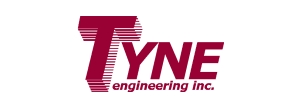Tritium Controller
Model: 7000
Application
Tyne's Tritium Controller is the main data processing centre for many of our tritium monitoring configurations. It is suitable for in-line monitoring of process systems, glove box monitoring, stack monitoring, room air monitoring, and other applications such as with Tyne's tritium-in-breath analyzer.
It can be configured for a variety of tritium monitoring requirements, including inputs from one or two ion chambers of different sizes and sensitivities (see Tyne's 1000cc ion chamber and 10cc ion chamber), multiple alarm configurations, and multiple range configurations.
Features
-
Large flat panel touch screen
-
Controls up to two detectors
-
Dual Alarm per channel, local and remote
-
One Touch auto zeroing
-
4-20 mA, 0-10V or RS232 output
-
Smooth Auto Ranging across 9 decades

Description
The Tritium Controller carries out the signal processing for multi-range tritium detector heads (ionization chamber with preamplifier). It is operated by a large, touch screen mounted on the front panel, it has an easy-to-read display and a full set of menu options.
Touchscreen control panel
The controller can seamlessly auto range two detectors across 9 decades. Each channel has two user settable alarms. Each alarm has a local visual and audible annunciation as well as a 30 VDC/AC 1A relay for a remote alarm or process actuation, such as valves.
The multi-range function gives the maximum sensitivity as well as a very large dynamic measurement range from 1 µCi/m³ to 1 Ci/m³ so that itwill always be able to track total tritium inventory within the loop being measured.
With either a Voltage or Current output option, digital range indication or RS-232 output integration into a data handling system is easy.
The measured signal is also output in analog form as either 0-10V or 4-20mA. The controller may be connected to a computer through the digital RS232 for remote display.

Back view of controller
To help compensate for any background drift in the detectors, the controller has a simple one touch auto-zeroing function. This will zero the entire system across all the measurement ranges.
The controller comes in a standard 3U (4.5”) 19” rack mountable enclosure.
The detection heads can be installed remotely up to 100m from the controller. The detector heads can be either a 1000cc or 10cc detection volume. The 1000cc volume gives the maximum amount of sensitivity to 1 µCi/m³ while the 10cc volume which has a “virtual wall” comprising two nesting cages, gives the highest range of 10,000 kCi/m³ with minimal tritium contamination due to the small metal surface area. Both detector heads have a small in-line footprint with VCR 8/VCR 4 connections, ideal for installing directly into the piping system. They are both pressure vessels that can handle up to 150 psig, can be heated to 350°C without damage, and are 1x10-9 helium leak tight to conform to current tritium handling standards. The detector heads are of stainless steel construction with a ceramic insulator and an electro-polished interior to minimize tritium surface contamination. In the event of contamination the detectors are easily flushed with air to decontaminate them.
For gamma compensation a second detector head maybe installed alongside the first head that is measuring the process loop. The compensation detector head, which has no gas flowing through it, will measure the signal from gamma sources and can be subtracted from the detector head that is measuring the gas in the process loop.
The external electronics of a detector head is inside an enclosure that can be made leak tight and can beconnected to a purge gas. This will protect the detector heads in an explosive atmosphere so they may be placed in a hydrogen environment. Purging the electronics to provide cooling is also suggested if the detector head may be operated at temperatures exceeding 50°C.
Specifications
Note: Specifications depend on configuration and ion chamber selection.
| Detection Sensitivity with 1000 cc Detector | 1 µCi/m3 |
| Detection Sensitivity with 10 cc Detector | 0.1 mCi/m³ |
| Instrument Response Time | less than 10 s |
| Detection Range with 1000 cc Detector | 0 to 10 Ci/m3 |
| Detection Range with 10 cc Detector | 0 to pure tritium |
| Flow Rates with 1000 cc Detector | 1000 cc/s recommended, 2000 cc/sec max |
| Flow Rates with 10 cc Detector | 1000 cc/s |
| Operating Pressure | Vacuum to 150 psig |
| Operating Temperature (ion chambers) | 15 °C to 200 °C |
| Operating Temperature (controller) | 0°C to 50°C |
| Operating Humidity | 0% - 95% Relative Humidity |
| Leak Tightness | less than 1x10-9 atm-cc/s He |
| Temperature Offset | Under 1 µCi/°C |
| Gamma Offset | 0.1 Ci/m3 per 1 R/h gamma fieldLinear response from 10-3 R/h to 102 R/h |
| Gamma Compensation | Subtract with 2nd detector head |
| Background Compensation | "One touch" Auto Zero |
| Tritium Recovery | Chamber bakeable up to 350°C |
| Tritium Wetted Parts | 316L Stainless Steel, High density Ceramic |
| Fittings | VCR8 |
| Controller Placement | Up to 100m from detector head |
| Analogue Output | 0 - 10 V |
| Current Output | 4 - 20 mA |
| Digital Output | RS232 |
| Range Indication | 3 digital output lines |
| Process Alarm | Two alarm set points per channel |
| Process Control on Alarm | Alarm Relay, 30 VAC/DC, dry contact relay |
| Compliance | DOE Tritium Monitor Standard Rev 4 June 1999, ISO 9001:2000 |
| Power Requirements | 1A, 120 VAC, 50/60 Hz1/2A, 220 VAC 50/60 Hz |
| Dimensions of Controller | Standard 19" rack mount x 5" Height |
| Dimensions of 1000 cc Detector | 4.5" diameter x 15" length |
| Dimensions of 10 cc Detector | 3" diameter x 15" length |
| Power | 120 VAC 1A or 220 VAC 1/2A 50/60Hz |


